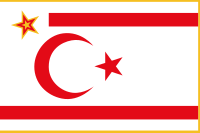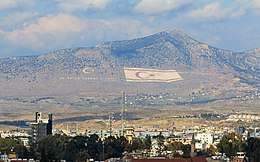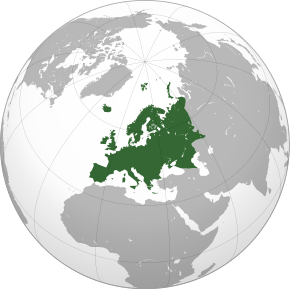Flag of Northern Cyprus
The flag of the Turkish Republic of Northern Cyprus (Turkish: Kuzey Kıbrıs Türk Cumhuriyeti Bayrağı) is based on the flag of Turkey with the colors reversed and two horizontal red stripes added at the top and bottom. The flag was drawn by Turkish Cypriot artist Emin Çizenel.[2][3] It was adopted in 1984 by the TRNC, a self-declared state that is recognised only by Turkey, after its unilateral declaration of independence in 1983. The TRNC succeeded the Turkish Federated State of Cyprus, also self-declared and recognised only by Turkey, which had been established in 1975 following the 1974 Turkish invasion of Cyprus, and had used the flag of Turkey.
 | |
| Use | National flag and ensign |
|---|---|
| Proportion | 2:3 |
| Adopted | 7 March 1984[1] |
| Design | A red star and crescent slightly to the left of the centre between two horizontal red bars on a white field. |
 Variant flag of the Turkish Republic of Northern Cyprus | |
| Name | Flag of the President of the Turkish Republic of Northern Cyprus |
| Use | Other |
| Proportion | 2:3 |
Kyrenia Mountain Range

A large North Cypriot flag image was drawn on the side of Beşparmaklar Mountain (Mount Pentadaktylos in Greek), in the Kyrenia Mountains, facing south (35.282902°N 33.375263°E). The star and crescent, an emblem of Turkey, and the quotation "Ne Mutlu Türküm Diyene" ("How happy is the one who says I am a Turk"), a motto of Kemalism, is written next to it. Located on the northern side of the green line in the divided capital Nicosia, it is widely visible in the south. An early version was made in the 1980s with stones; now teams from Turkey maintain the coloring with dyes.[4]
In 2010, Antigoni Papadopoulou, a Greek Cypriot Member of the European Parliament, submitted an official written question about the mountain flag to the EU Commission. The complaint framed it as an environmental hazard because of the chemical substances employed, and a waste of energy for the thousands of lights used to illuminate it at night. It also described the flag, first lit up on the Greek National Day, 28 October 2003, as an "unprecedented daily provocation" and a "hostile action", and requested that sanctions be imposed on Turkey for its conduct. The commission promised to launch an investigation into the environmental impact, but declined to comment on the political aspects.[5][6]
See also
- Flag of Turkey
- Flag of Cyprus
- Coat of arms of Northern Cyprus
- Gallery of flags with crescents
References
- "Turkish Republic of Northern Cyprus". Flagspot.net/flags/. Retrieved 27 April 2015.
- Kıbrıs Türk Tarihi (PDF) (6 ed.). TRNC Ministry of National Education. 2014. p. 87.
- "KKTC bayrağını Necmettin Erbakan'ın çizdiği iddiası" (in Turkish). teyit.org. Retrieved 16 December 2018.
- Jennings, Ken. "You Can See Northern Cyprus's Flag from Space". Condé Nast Traveler. Retrieved 2018-11-08.
- "EU to investigate whether KKTC flag is environmental hazard". TODAY’S ZAMAN. 3 Feb 2010. Archived from the original on 21 September 2013. Retrieved 25 February 2013.
- "Written question - Turkish flag on Mount Pentadaktylos - E-5053/2009". Website of the European Parliament. Retrieved 2018-11-08.
